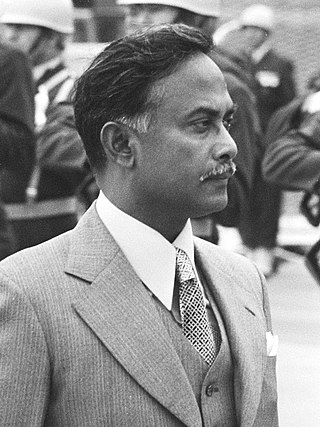
The Bangladesh Armed Forces are the military forces of the People's Republic of Bangladesh. They consist of the three uniformed military services: the Bangladesh Army, the Bangladesh Navy, and the Bangladesh Air Force. The Armed Forces are under the jurisdiction of the Ministry of Defence of the Government of Bangladesh, and are directly administered by the Armed Forces Division of the Prime Minister's Office. The President of Bangladesh serves as the Commander-in-Chief of the Bangladesh Armed Forces. Bangladesh has the third-largest defence budget in South Asia. The Bangladeshi military is also the 35th strongest in the world and the third most powerful military force in South Asia. Border Guard Bangladesh and Bangladesh Coast Guard are under the jurisdiction of the Ministry of Home Affairs during peacetime, but during wartime, they fall under the command of the Bangladesh Army and the Bangladesh Navy, respectively.
The Japanese Red Army was a militant communist organization active from 1971 to 2001. It was designated a terrorist organization by Japan and the United States. The JRA was founded by Fusako Shigenobu and Tsuyoshi Okudaira in February 1971, and was most active in the 1970s and 1980s, operating mostly out of Lebanon with PFLP collaboration and funding from Muammar Gaddafi's Libya, as well as Syria and North Korea.

Ziaur Rahman was a Bangladeshi military officer and politician who served as the sixth President of Bangladesh from 1977 until his assassination in 1981. One of the leading figures of country's independence war, he broadcast the Bangladeshi declaration of independence in March 1971 from Chittagong. He was the founder of Bangladesh Nationalist Party (BNP). He previously served as the third chief of army staff from 1975 to 1978 with a minor break.

The Bangladesh Air Force (BAF) is the aerial warfare branch of the Bangladesh Armed Forces. The air force is primarily responsible for air defence of Bangladesh's sovereign territory as well as providing air support to the Bangladesh Army and Bangladesh Navy. Furthermore, the BAF has a territorial role in providing tactical and strategic air transport and logistics capability for the country.

Japan Air Lines Flight 472 was an international flight that was hijacked by the Japanese Red Army (JRA) en route from Bombay to Tokyo on 28 September 1977.
Abu Taher BU was a Bangladeshi military officer and war hero. He first served in the Pakistan Army, and later defected to the Bangladesh Army during the Bangladesh Liberation War. He crossed into India around early August and reported to the Indian authorities. After a week screening at Dehradun, India, Taher reported to Kolkata, Bangladesh Provincial government at 8 Theatre Rd. He was ordered to report to Sector 11 of Mukti Bahini under command of Major Ziaur Rahman, he became the sector commander after him. He served in BDF from end of August to 2 November 1971. He was awarded the medal Bir Uttom for his gallantry in the liberation war. He was released from military service by Indian military medical board in Pune, India after his leg was amputated. After independence, he was inducted into the Bangladesh Army for administrative retirement with legacy rank of lieutenant colonel. After settling in with family, the government of Bangladesh appointed him with employment at Kumilla. Later Taher turned into a political activist and leader of the left-wing Jatiyo Samajtantrik Dal.

Bangladesh has undergone several changes of government since the Proclamation of Independence in 1971. Between the first recorded coup in August 1975 and the 2009 Bangladesh Rifles revolt, Bangladesh has been through as many as 29 military coups.

Ziaur Rahman, the sixth president of Bangladesh, was assassinated by a faction of officers of Bangladesh Army, on 30 May 1981, in the southeastern port city of Chittagong. Rahman went to Chittagong to arbitrate in a clash between the local leaders of his political party, the Bangladesh Nationalist Party (BNP). On the night of 30 May, a group of officers commandeered the Chittagong Circuit House, a government residence where Rahman was staying, shooting him and several others.
Shafaat Jamil, Bir Bikrom was a Bangladesh Army colonel. He was the commanding officer of the 3rd East Bengal Regiment of Z Force Brigade in Sector 11 of Bangladesh Forces during the War of Bangladesh Independence in 1971. He was among the first Bengali officers who rebelled against the Pakistani Army in the 1971 Liberation War of Bangladesh and later fought in 11 sector and in Sylhet sector.

The history of aviation in Bangladesh began with kites, the traditional heavier-than-air man-made object, that is flown by one or more people while staying on the ground. The first recorded manned flight was arranged by the Dhaka Nawab Family in 1892, which resulted in the death of the flyer.
1977 (MCMLXXVII) was a common year starting on Saturday of the Gregorian calendar, the 1977th year of the Common Era (CE) and Anno Domini (AD) designations, the 977th year of the 2nd millennium, the 77th year of the 20th century, and the 8th year of the 1970s decade.

Bangladesh Rifles revolt, also referred to as the Pilkhana tragedy or the Pilkhana Massacre, was a mutiny staged on 25 and 26 February 2009 in Dhaka by a section of the Bangladesh Rifles (BDR), a paramilitary force mainly tasked with guarding the borders of Bangladesh. The rebelling BDR soldiers took over the BDR headquarters in Pilkhana, killing BDR director-general Shakil Ahmed along with 56 other army officers and 17 civilians. They also fired on civilians, held many of their officers and their families hostage, vandalised property and looted valuables. By the second day, unrest had spread to 12 other towns and cities. The mutiny ended as the mutineers surrendered their arms and released the hostages after a series of staged discussions and negotiations with the government.
Air Vice Marshal (retd.) Abdul Ghaffar Mahmud is a former chief of the Bangladesh Air Force. He negotiated the release of hostages from the hijacked Japan Airlines Flight 472. For his role in keeping the situation under control and securing the lives of every single passenger, the Japanese government conferred upon him the "Order of the Rising Sun, Gold and Silver Star" awards.
The 1977 Bogra mutiny was a mutiny in Bogra Cantonment, a military station near the city of Bogra in Bangladesh on 30 September 1977.

The military coup in Bangladesh on August 15 of 1975 was launched by mid-ranking army officers in order to assassinate founding president Sheikh Mujibur Rahman, whose administration post-independence grew corrupt and reportedly authoritarian until he established a one-party state-based government led by the socialist party Bangladesh Krishak Sramik Awami League. Mujib, along with his resident family members, were killed during the coup but was survived by his two then-expat daughters, one of them being future prime minister Sheikh Hasina. The officers were led by Capt. Abdul Majed, Major Sayed Farooq-ur-Rahman, Major Khandaker Abdur Rashidand Major Shariful Haque Dalim.

The 7 November 1975 Bangladesh coup d'état, also known as the Sipahi–Janata Revolution, was launched by left-wing soldiers (Sipahi) of Biplobi Shainik Sangstha (BSS) under the leadership of Col. (retd.) Abu Taher.

The Biplobi Shainik Sangstha was a clandestine revolutionary socialist group of sepoy mutineers within the Bangladesh Army, active from 1973 to 1975. The BSS was formed by the vanguard socialist-revolutionary party Jatiya Samajtantrik Dal (JaSaD) and led by Maj. M.A. Jalil and Lt. Col. (retd.) Abu Taher. The BSS is known for staging the 7 November 1975 coup through the Sipahi–Janata Revolution, which would eventually make way for the rise of Lt. Gen. Ziaur Rahman in the country's politics.
The 1976 Bogra mutiny was a rebellion on 30 April 1976 of Bangladesh Army soldiers stationed in Bogra Cantonment.

Beginning on 9 October 1977, the government of Ziaur Rahman carried out mass executions of military personnel, following a series of attempted coups in Bangladesh. According to official records, 1143 members of the Bangladesh armed forces were hanged in two months, following 9 October 1977. This was the first mass execution of military personnel on this scale in South Asia.











